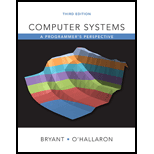
Concept explainers
A.
IP addresses:
- The IP address denotes an unsigned integer that is 32-bit.
- The IP addresses is been stored by network programs in IP address structure.
- The addresses present in IP address structure are stored in network byte order.
- An unsigned 32-bit integer is transformed from host byte order to network byte order by “htonl” function.
- An unsigned 32-bit integer is transformed from network byte order host byte order by “ntohl” function.
- The IP address is presented to humans in a form known as “dotted-decimal” notation.
- Each byte is been represented by its corresponding decimal value and is separated by a period from other bytes.
Passing
- The arguments for “GET” requests are passed in the URI.
- The character “?” separates filename from the arguments.
- The character “&” separates each argument.
- The arguments do not allow spaces in it.
Server passes arguments to child:
- The server calls “fork” to create a child process and calls “execve” to run program in child’s context once it receives a request.
- The child process sets CGI environment variable values.
- The “adder” program can reference it at run time using “getenv” function of linux.
Output is sent by child:
- The dynamic content of a CGI program is to be sent to standard output.
- A CGI program sends dynamic content to standard output.
- It uses “dup2” function for redirecting standard output to connected descriptor associated with client.
- The result written to standard output by CGI program, it goes directly to client.
A.
Explanation of Solution
Modified C code:
//Define method
void clienterror(int fd, char *cause, char *errnum, char *shortmsg, char *longmsg);
//Define method
void echo(int connfd);
//Define main method
int main(int argc, char **argv)
{
//Declare variables
int listenfd, connfd;
//Call method
Getnameinfo((SA *) &clientaddr, clientlen, hostname, MAXLINE,port, MAXLINE, 0);
//Display message
printf("Accepted connection from (%s, %s)\n", hostname, port);
//Call method
echo(connfd);
//Close
Close(connfd);
}
//Define method
void echo(int connfd)
{
//Declare variable
size_t n;
//Declare array
char buf[MAXLINE];
//Declare variable
rio_t rio;
//Call method
Rio_readinitb(&rio, connfd);
//Loop
while ((n = Rio_readlineb(&rio, buf, MAXLINE)) != 0)
{
//If condition satisfies
if (strcmp(buf, "\r\n") == 0)
//Break
break;
//Call method
Rio_writen(connfd, buf, n);
}
}
Explanation:
- The method “echo” declares the variables first.
- It handles one HTTP response/request transaction.
- The value is been read using method “readinitb” and is stored.
- The value is been written into buffer using “written” method.
- The comparison is made until new line occurs.
B.
IP addresses:
- The IP address denotes an unsigned integer that is 32-bit.
- The IP addresses is been stored by network programs in IP address structure.
- The addresses present in IP address structure are stored in network byte order.
- An unsigned 32-bit integer is converted from host byte order to network byte order by “htonl” function.
- An unsigned 32-bit integer is converted from network byte order host byte order by “ntohl” function.
- The IP address is presented to humans in a form known as “dotted-decimal” notation.
- Each byte is been represented by its corresponding decimal value and is separated by a period from other bytes.
Passing program arguments to server:
- The arguments for “GET” requests are passed in the URI.
- The character “?” separates filename from the arguments.
- The character “&” separates each argument.
- The arguments do not allow spaces in it.
Server passes arguments to child:
- The server calls “fork” to create a child process and calls “execve” to run program in child’s context once it receives a request.
- The child process sets CGI environment variable values.
- The “adder” program can reference it at run time using “getenv” function of linux.
Output is sent by child:
- The dynamic content of a CGI program is to be sent to standard output.
- A CGI program sends dynamic content to standard output.
- It uses “dup2” function for redirecting standard output to connected descriptor associated with client.
- The result written to standard output by CGI program, it goes directly to client.
B.
Explanation of Solution
Request to TINY for static content:
GET / HTTP/1.1
Host: localhost:5000
User-Agent: Mozilla/5.0 (X11; Ubuntu; Linux x86_64; rv:53.0) Gecko/20100101 Firefox/53.0
Accept: text/html,application/xhtml+xml,application/xml;q=0.9,*/*;q=0.8
Accept-Language: en-US,en;q=0.5
Accept-Encoding: gzip, deflate
Connection: keep-alive
Explanation:
- The given code denotes a request to “TINY” for static content.
- It echoes each and every request line.
- It echoes each and every request header.
- It takes a particular “Accept-Language” and “Accept-Encoding” for the content.
C.
IP addresses:
- The IP address denotes an unsigned integer that is 32-bit.
- The IP addresses is been stored by network programs in IP address structure.
- The addresses present in IP address structure are stored in network byte order.
- An unsigned 32-bit integer is converted from host byte order to network byte order by “htonl” function.
- An unsigned 32-bit integer is converted from network byte order host byte order by “ntohl” function.
- The IP address is presented to humans in a form known as “dotted-decimal” notation.
- Each byte is been represented by its corresponding decimal value and is separated by a period from other bytes.
Passing program arguments to server:
- The arguments for “GET” requests are passed in the URI.
- The character “?” separates filename from the arguments.
- The character “&” separates each argument.
- The arguments do not allow spaces in it.
Server passes arguments to child:
- The server calls “fork” to create a child process and calls “execve” to run program in child’s context once it receives a request.
- The child process sets CGI environment variable values.
- The “adder” program can reference it at run time using “getenv” function of linux.
Output is sent by child:
- The dynamic content of a CGI program is to be sent to standard output.
- A CGI program sends dynamic content to standard output.
- It uses “dup2” function for redirecting standard output to connected descriptor associated with client.
- The result written to standard output by CGI program, it goes directly to client.
C.
Explanation of Solution
Version of HTTP:
- The version of HTTP used by browser is HTTP 1.1.
- The output from “TINY” is been inspected for determining HTTP version of browser.
- The “TINY” denotes an iterative server that listens for connection requests on ports.
- The “TINY” executes infinite server loop; it accepts a connection request repeatedly.
- It performs the transaction and closes its end of connection.
- Hence, version of HTTP is “HTTP 1.1”.
D.
IP addresses:
- The IP address denotes an unsigned integer that is 32-bit.
- The IP addresses is been stored by network programs in IP address structure.
- The addresses present in IP address structure are stored in network byte order.
- An unsigned 32-bit integer is converted from host byte order to network byte order by “htonl” function.
- An unsigned 32-bit integer is converted from network byte order host byte order by “ntohl” function.
- The IP address is presented to humans in a form known as “dotted-decimal” notation.
- Each byte is been represented by its corresponding decimal value and is separated by a period from other bytes.
Passing program arguments to server:
- The arguments for “GET” requests are passed in the URI.
- The character “?” separates filename from the arguments.
- The character “&” separates each argument.
- The arguments do not allow spaces in it.
Server passes arguments to child:
- The server calls “fork” to create a child process and calls “execve” to run program in child’s context once it receives a request.
- The child process sets CGI environment variable values.
- The “adder” program can reference it at run time using “getenv” function of linux.
Output is sent by child:
- The dynamic content of a CGI program is to be sent to standard output.
- A CGI program sends dynamic content to standard output.
- It uses “dup2” function for redirecting standard output to connected descriptor associated with client.
- The result written to standard output by CGI program, it goes directly to client.
D.
Explanation of Solution
Meaning of HTTP headers:
- The details of each HTTP header is shown below:
- Accept:14.1:
- It can be used for specifying certain media types that are acceptable for response.
- Accept headers are used to indicate that request is limited specifically to a small set of desired types.
- It has same impact as in case of an in-line image request.
- Accept-Encoding: 14.3:
- The request header field is almost similar to “Accept”.
- It restricts the content-coding that are acceptable in response.
- Accept-Language: 14.4:
- The “Accept-Language” request header is similar to that of “Accept”.
- It restricts set of natural languages preferred as response to request.
- Connection: 14.10:
- The connection header field allows sender to specify options that are desired for particular connection.
- It must not be communicated by proxies over further connections.
- Host: 14.23:
- The host request header field would specify internet host and port number of resource being requested.
- The host field value denotes origin server’s naming authority or gateway given by original URL.
- It allows origin server or gateway in differentiating between ambiguous URLs.
- The root “/” server’s URL is used for multiple host names with single IP address.
- User-Agent: 14.43:
- The user-agent request header has information about user agent initiating the request.
- It is used for tracing protocol violations, automated acknowledgment of user agents for avoiding limitations of user agent.
- The requests are been added with the field.
- The field contains multiple product tokens and comments that identifies agent.
- It includes sub products that forms a significant part of user agent.
- The product tokens are listed in order of their significance for application identification.
- Accept:14.1:
Want to see more full solutions like this?
Chapter 11 Solutions
Computer Systems: A Programmer's Perspective Plus Mastering Engineering With Pearson Etext -- Access Card Package (3rd Edition)
- Need help with coding in this in python!arrow_forwardIn the diagram, there is a green arrow pointing from Input C (complete data) to Transformer Encoder S_B, which I don’t understand. The teacher model is trained on full data, but S_B should instead receive missing data—this arrow should not point there. Please verify and recreate the diagram to fix this issue. Additionally, the newly created diagram should meet the same clarity standards as the second diagram (Proposed MSCATN). Finally provide the output image of the diagram in image format .arrow_forwardPlease provide me with the output image of both of them . below are the diagrams code make sure to update the code and mentionned clearly each section also the digram should be clearly describe like in the attached image. please do not provide the same answer like in other question . I repost this question because it does not satisfy the requirment I need in terms of clarifty the output of both code are not very well details I have two diagram : first diagram code graph LR subgraph Teacher Model (Pretrained) Input_Teacher[Input C (Complete Data)] --> Teacher_Encoder[Transformer Encoder T] Teacher_Encoder --> Teacher_Prediction[Teacher Prediction y_T] Teacher_Encoder --> Teacher_Features[Internal Features F_T] end subgraph Student_A_Model[Student Model A (Handles Missing Values)] Input_Student_A[Input M (Data with Missing Values)] --> Student_A_Encoder[Transformer Encoder E_A] Student_A_Encoder --> Student_A_Prediction[Student A Prediction y_A] Student_A_Encoder…arrow_forward
- Why I need ?arrow_forwardHere are two diagrams. Make them very explicit, similar to Example Diagram 3 (the Architecture of MSCTNN). graph LR subgraph Teacher_Model_B [Teacher Model (Pretrained)] Input_Teacher_B[Input C (Complete Data)] --> Teacher_Encoder_B[Transformer Encoder T] Teacher_Encoder_B --> Teacher_Prediction_B[Teacher Prediction y_T] Teacher_Encoder_B --> Teacher_Features_B[Internal Features F_T] end subgraph Student_B_Model [Student Model B (Handles Missing Labels)] Input_Student_B[Input C (Complete Data)] --> Student_B_Encoder[Transformer Encoder E_B] Student_B_Encoder --> Student_B_Prediction[Student B Prediction y_B] end subgraph Knowledge_Distillation_B [Knowledge Distillation (Student B)] Teacher_Prediction_B -- Logits Distillation Loss (L_logits_B) --> Total_Loss_B Teacher_Features_B -- Feature Alignment Loss (L_feature_B) --> Total_Loss_B Partial_Labels_B[Partial Labels y_p] -- Prediction Loss (L_pred_B) --> Total_Loss_B Total_Loss_B -- Backpropagation -->…arrow_forwardPlease provide me with the output image of both of them . below are the diagrams code I have two diagram : first diagram code graph LR subgraph Teacher Model (Pretrained) Input_Teacher[Input C (Complete Data)] --> Teacher_Encoder[Transformer Encoder T] Teacher_Encoder --> Teacher_Prediction[Teacher Prediction y_T] Teacher_Encoder --> Teacher_Features[Internal Features F_T] end subgraph Student_A_Model[Student Model A (Handles Missing Values)] Input_Student_A[Input M (Data with Missing Values)] --> Student_A_Encoder[Transformer Encoder E_A] Student_A_Encoder --> Student_A_Prediction[Student A Prediction y_A] Student_A_Encoder --> Student_A_Features[Student A Features F_A] end subgraph Knowledge_Distillation_A [Knowledge Distillation (Student A)] Teacher_Prediction -- Logits Distillation Loss (L_logits_A) --> Total_Loss_A Teacher_Features -- Feature Alignment Loss (L_feature_A) --> Total_Loss_A Ground_Truth_A[Ground Truth y_gt] -- Prediction Loss (L_pred_A)…arrow_forward
 A+ Guide To It Technical SupportComputer ScienceISBN:9780357108291Author:ANDREWS, Jean.Publisher:Cengage,
A+ Guide To It Technical SupportComputer ScienceISBN:9780357108291Author:ANDREWS, Jean.Publisher:Cengage, EBK JAVA PROGRAMMINGComputer ScienceISBN:9781337671385Author:FARRELLPublisher:CENGAGE LEARNING - CONSIGNMENTNp Ms Office 365/Excel 2016 I NtermedComputer ScienceISBN:9781337508841Author:CareyPublisher:Cengage
EBK JAVA PROGRAMMINGComputer ScienceISBN:9781337671385Author:FARRELLPublisher:CENGAGE LEARNING - CONSIGNMENTNp Ms Office 365/Excel 2016 I NtermedComputer ScienceISBN:9781337508841Author:CareyPublisher:Cengage New Perspectives on HTML5, CSS3, and JavaScriptComputer ScienceISBN:9781305503922Author:Patrick M. CareyPublisher:Cengage Learning
New Perspectives on HTML5, CSS3, and JavaScriptComputer ScienceISBN:9781305503922Author:Patrick M. CareyPublisher:Cengage Learning LINUX+ AND LPIC-1 GDE.TO LINUX CERTIF.Computer ScienceISBN:9781337569798Author:ECKERTPublisher:CENGAGE L
LINUX+ AND LPIC-1 GDE.TO LINUX CERTIF.Computer ScienceISBN:9781337569798Author:ECKERTPublisher:CENGAGE L





